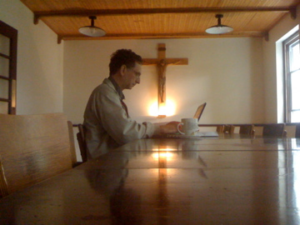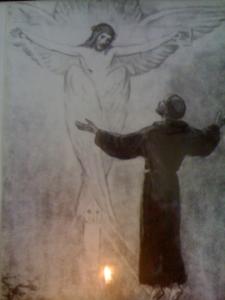Signs
A reflection on a morning prayer
By Robert Moynihan, reporting from America
This September morning dawned cool in the friary in Yonkers.
I wrote last time about evening prayer. But there is also morning prayer. (I write in the dining room of the friary, photo below).
 Morning prayer today in this Franciscan friary was devoted to two things worthy of note (this is, after all, a “good news” flash):
Morning prayer today in this Franciscan friary was devoted to two things worthy of note (this is, after all, a “good news” flash):
(1) today, for Franciscans, is the Feast of the Stigmata of Our Holy Father Francis; and
(2) today, for the Universal Church, is the Feast of St. Robert Bellarmine, who died in 1621.
Since my name is Robert, today is therefore also my name day.
In Italy, the name day — the day of the saint whose name one bears, called the “onomastico” — is celebrated like a birthday… because it is, in a sense, a birthday.
We are born into the world, nameless, and the day we are born is the day of our physical birth.
Then we are named, and the day of our naming (or rather, the day of the Feast of the one we are named for) is the “birthday” of our identity.
So if anyone would like to send me “name day” greetings, I would be happy to receive them! And a blessed name day to all of you named Robert…
Today is the anniversary of that September day in 1224, 785 years ago, on Mount Alverna in central Italy, when St. Francis received the stigmata.
He was the first known case of this phenomena occurring.
Since Francis, it has occurred many times, most notably, perhaps, in the case of Padre Pio, who died in 1968.
 In the friary chapel this morning, in front of the altar, there is a picture of Christ appearing in front of St. Francis, his arms outstretched. (photo left)
In the friary chapel this morning, in front of the altar, there is a picture of Christ appearing in front of St. Francis, his arms outstretched. (photo left)
In this and other images of this type, one sees and senses that some kind of spiritual power is imprinting, almost like a photocopy, the nature of Christ upon the nature of the little Italian man who followed Christ 800 years ago.
And in some drawings, there are lines which are traced from Christ’s hand to Francis’s hand, from Christ’s feet to Francis’s feet, from Christ’s side to Francis’s side.
What is happening?
The artists are showing that the wounds of Christ are being transferred from Christ to Francis, mystically, and in reality.
St. Bonaventure — whose thought was so influential also on the young Joseph Ratzinger, now Pope Benedict XVI — explains the stigmata this way (the words are posted on a sheet of paper just outside the chapel this morning, where I read them; photo below):
“In these latter times,” Bonaventure wrote in the mid-1200s, “the Lord has bestowed the signs of goodness and mercy on St. Francis to enkindle love, and what are the signs of consummate love except the marks of the passion which God chose to endure for us out of measureless love?
 “Hugh of St. Victor tells us: ‘Such is the power of love, that it transforms the lover into the Beloved.’
“Hugh of St. Victor tells us: ‘Such is the power of love, that it transforms the lover into the Beloved.’
Bonaventure concludes: “Love of the Crucified Lord was supremely and gloriously aflame in his heart, and so the Crucified Himself, in the form of the Seraph, an angelic spirit burning with the fire of love, appeared before his saintly eyes and imprinted the sacred stigmata on his body.”
There is not time here to go into all aspects of the stigmata, and how they have been received and interpreted over the centuries.
But I would like to suggest one important thing: for St. Bonaventure, the stigmata of St. Francis were more than a personal, mystical phenomenon.
They were an “apocalyptic” (“apocalyptic” in the sense of “revelatory”) sign with significance for world history.
For St. Bonaventure saw in Francis, marked with Christ’s wounds on his own physical body, as the sign that a new age on salvation history was beginning.
Bonaventure interpreted Francis as “the angel of the sixth seal” mentioned in the Book of Revelation, the one “sealed with the seal of the Living God,” that is, with the wounds of Christ.
But what all this meant then, or means now, is a matter for another email, or more than one…
In the book entitled Proper Offices of Franciscan Saints and Blesseds in the Liturgy of the Hours — for every religious order has its own, its “proper”, feast days during the year, along with those feasts which are celebrated throughout the entire Church, which is one of the great riches of the Catholic tradition — this explanation is given for this feast:
“From the beginning of his conversion our Seraphic Father Saint Francis had a very great devotion and veneration for Christ crucified and never ceased to preach this devotion till his death. In the year 1224, as he was rapt in deep contemplation on Mt. Alverna, Christ the Lord by a stupendous miracle imprinted the marks of his passion on the saint’s body. Pope Benedict XI permitted the Franciscan Order to celebrate annually on this day the memory of this extraordinary event attested by reliable witnesses.”
In our time, the stigmata — the wounds of Christ imprinted on the body of a living person — are regarded by many as rather strange phenomena.
Many think the wounds are “psychosomatic”, that is, produced by a type of morbid psychological process in which the mind, having concentrated so profoundly on Christ, “produces” actual wounds in the flesh, like a rash, or a swelling, or a boil.
But this seems too simplistic, too “reductionist,” and, frankly, too dismissive of the actual facts.
For, if one reads closely what witnesses testified to about these signs, these wounds, one finds that they saw not only wounds in the flesh, but even the nails that made the wounds.
The second reading this morning is from the Legenda Maior, the biography of St. Francis written by St. Bonaventure in 1263, about 37 years after Francis’s death.
Bonaventure writes: “When the vision vanished… it left marks on his body like those of the Crucified as if the impression of a seal had been left on heated wax. The figures of the nails appeared immediately on his hands and feet. The heads of the nails were inside his hands but on top of his feet with their points extending through to the opposite side. His right side too showed a blood-red wound as if it had been pierced by a lance, and blood flowed frequently from it.”
(These nails were not of iron, but of flesh, as other witnesses make clear. The flesh “hardened”or “congealed” into what appeared to be a nail head and a nail inside the wounds.)
Now, one could imagine it might be possible for wounds to appear in a person’s body due to some sort of psychological effect of the mind on the body.
But it is difficult — and, in fact, for me, impossible — to imagine that the mind could cause also the instruments of the wounds to appear, as Bonaventure describes, on the inside of the hands, and the top of the feet, with the nails extending through to the opposite side.
Today is the Feast day which celebrates this mysterious event — the Stigmata.
The first reading this morning offers some material for reflection on the possible meaning of the Stigmata.
“Those who belong to Christ Jesus,” writes St. Paul in his letter to the Galatians, “have crucified their flesh with its passions and desires…”
This is a central point of Christian teaching: that all Christians, in some way, at least spiritually, are “crucified,” as Jesus was.
Paul continues: “Make no mistake about it, no one makes a fool of God! A man will reap only what he sows. If he sows in the field of the flesh, he will reap a harvest of corruption; but if his seed-ground is the spirit, he will reap everlasting life… While we have the opportunity, let us do good to all men — but especially those of the household of the faith.”
And he concludes: “May I never boast of anything but the cross of our Lord Jesus Christ! Through it, the world has been crucified to me, and I to the world. It means nothing whether one is circumcised or not. All that matters is that one is created anew. Peace and mercy on all who follow this rule of life, and on the Israel of God. Henceforth, let no man trouble me, for I bear the brand marks of Jesus in my body…”
Surprisingly, these last works suggest that Paul himself, at least spiritually, had experienced the wounds of Christ. So this is not simply a phenemenon of the Middle Ages. Spiritually, it is something that goes back to the very birth of Christianity.
These lines of Paul contain much material for reflection, and one can only gather fragments of thoughts to share.
I do feel that it is a “hard saying” to speak of this world, this physical reality (metaphorically summed up in the word “flesh) as something to be “crucified,” as something tending toward “corruption” and not “life.”
It seems so contradictory, so out of keeping with the idea that created reality is “good.”
It seems, I dare to say, so “pre-conciliar.”
(It is a “hard saying,” also, at least at first sight, I think, for the proponents of the “theology of the body.”)
But the essence of Paul’s teaching here is a simple truth: this physical reality, this “flesh” — in the state and condition that we find it, that is, as it is — is incapable of eternity.
It declines and it dies.
All flesh goes down to the grave.
Then where is hope?
Hope is in the spirit — the soul.
The spirit is capable of eternity.
But not an amorphous spirit, formless, nameless.
It is the spirit of the crucified one, Jesus of Nazareth, and his spirit can be shared by those who follow the path he himself took when he walked here among us… a path which led to the cross, and the wounds, which he bore even after his Resurrection.
Today is also the Feast of St. Robert Bellarmine, the “hammer of heretics,” the Jesuit archbishop of Capua who lived and worked just after the Council of Trent (held in the middle of the 1500s).
He was, perhaps, the greatest of the counter-Reformation theologians.
In his honor, I am visiting Father Benedict Groeschel, and also Dr. Alice von Hildebrand, who has some documents she wishes to give to me. I hope I can have the spirit of Bellarmine, in the days to come.
Bellarmine wrote about the coming of the Antichrist.
He wrote: “For it must be known that in the divine letters the Holy Spirit has given six sure signs concerning the coming of the Antichrist: two which precede him, namely the preaching of the Gospel in the whole world and the devastation of the Roman Empire; two contemporaneous, the coming of the two men (the two witnesses), Enoch and Elias, and the greatest and final persecution and also that the public sacrifice (of the Mass) shall completely cease; and two following signs, the death of the Antichrist after 3 and 1/2 years (after his rise to power) and the end of the world, neither of which signs have we seen at this time.”
I note also that a Russian Orthodox Archbishop, Hilarion Alfeyev, 42, the head of the Department of External Relations of the Patriarchate of Moscow, is in Rome this week, meeting with Vatican officials, and tomorrow, with Pope Benedict XVI at Castel Gandolfo.
Hilarion, whom I have come to know well during the past 10 years, is a man of deep Christian faith. An Oxford-trained scholar, he wrote his dissertation on St. Symeon the New Theologian.
The subject of Pope Benedict’s talk at his Wednesday General Audience yesterday was — St. Symeon.
A coincidence…?
Certainly the meetings between Roman officials and the chief representative of the Patriarch of Moscow are important, perhaps historic, and they may have some meaning in light of the prophecy of Fatima, that, in the end, Russia will be converted, and a period of peace be granted to the world, before the final acts of the drama of salvation history take place.
“He that takes truth for his guide, and duty for his end, may safely trust to God’s providence to lead him aright.” —Blaise Pascal (French mathematician, philosopher, physicist and writer, 1623-1662)







Facebook Comments